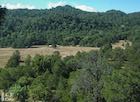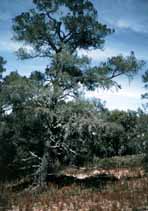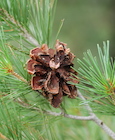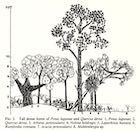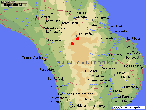Pinus lagunae
(Rob.-Pass.) Passini 1987
Common names
Laguna piñon (Perry 1991).
Taxonomic notes
Type: Mexico, Baja California Sur, Sierra de la Laguna, La Laguna, M.F. Robert 10021 (holo P). Syn: Pinus cembroides var. lagunae Rob.-Pass. 1981; Pinus cembroides subsp. lagunae (Rob.-Pass.) D.K.Bailey 1983. See P. cembroides for a discussion of the systematics of the piñons, including the finding that multiple lines of evidence support recognition of P. lagunae at species rank, with subsequent introgression where the distributions of the two taxa intersect.
Description
Monoecious evergreen trees to 25 m tall and 58 cm dbh. Leaves in fascicles of (2-)3, 40-70 × 0.8-0.9 mm, dull or grayish green. Seeds 10-16 × 6-10 mm with a 0.5-0.8 mm thick seed coat; fresh megagametophyte pinkish (Farjon 2010, Passini and Pinel 1989). Pollen dispersal occurs in May-June (Passini and Pinel 1987). See Passini and Pinel (1987) for detailed discussion of variance in diagnostic characters.
P. lagunae is taller than P. cembroides (maximum height twice as great), has substantially longer leaves (4–7 vs. 2-5 cm), and has a variety of consistent differences in leaf anatomy (Farjon 2010, Whang et al., 2001).).
Distribution and Ecology
Mexico: Baja California Sur: Sierra de la Laguna, at 1200-2000 m (Perry 1991). The climate is subtropical and summer-wet, with annual precipitation (200-)580(-800); average monthly temperatures range from 12°C in January to 25°C in July (Passini and Pinel 1989). The soils are acid (pH = 5-7) and sandy in texture. The area is an exposed granitic batholith with a summit elevation of 2090 m, and nearly all trees are at above 1600 m; most are around La Laguna, a sandy loam meadow, in a woodland dominated by Quercus devia (although P. lagunae is locally dominant), with understory species including Yucca, Caliandra and Dodonea. As with nearly every other Mexican pine, the species is likely co-adapted with fire, but no details are yet known (Farjon 2013). See Leon and Domínguez (1989) and Passini and Pinel (1989) for detailed climate and floristic data.
Pines of the Pinus cembroides complex. Red is P. lagunae. Purple diamonds are P. cembroides ssp. cembroides, purple stars are P. cembroides ssp. orizabensis, green is P. culminicola, blue is P. discolor, brown is P. johannis, and gold is P. remota. Based on GBIF.org downloads https://doi.org/10.15468/dl.pfuj4k (P. culminicola), https://doi.org/10.15468/dl.vvju45 (P. remota), and https://doi.org/10.15468/dl.5k7x9y (all other taxa), accessed 2023.03.09, with location uncertainty <10 km, and location duplicates removed.
The IUCN classifies this species as "Vulnerable" to human impacts due to a small area of occupancy (c. 11 km2) and a small population size of c. 1000 reproductively mature trees. Threats to the species consist mainly of logging, grazing, and fires (either through fire suppression or unseasonal burning), but the area is protected and little or no ongoing decline is evident. However, due to the small distribution, the species is vulnerable to stochastic events (Farjon 2013).
Remarkable Specimens
There are few size and age data available, but Passini and Pinel (1989) record trees to 21 m tall, 58 cm diameter, and 200 years old (ring-counted age). The oldest crossdated living specimen, 162 years, was documented in a tree-ring chronology covering the period 1833-1997 (fully crossdated), collected in the Sierra de la Laguna by José Villanueva (doi.org/10.25921/27b6-f009). This site was used in a dendroclimatic reconstruction of soil moisture balance (Stahle et al. 2016).
Ethnobotany
No current uses are known, but the species was logged in the past, likely for local use only. The population occurs within a protected area and logging has stopped (Farjon 2013). Pinus lagunae has been evaluated for use in dendrochronology. An exploratory study by Biondi and Fessenden (1999) found that the trees could not be crossdated due to high incidences of missing and "false" rings in a geographically tight collection of dominant trees. They conclude that this result may reflect low seasonality. I suspect that given its narrow range, further work with this species would be unproductive if it relied only on traditional optical methods to crossdate samples. See also Díaz et al. (1994).
Observations
I visited the Sierra de la Laguna in spring 1994 and spent a few days with this pine. Details of how to reach La Laguna are readily available on the Web and in guidebooks, but note that summer rainstorms can severely disrupt the road system, and access often requires a 4WD vehicle (or a short backpack trip). I understand that Pinus lagunae can also be seen from the so-called Naranjas Road in Southern Baja, south of the range shown here (I have to run down information on this occurrence). Drive to the summit, look north with binoculars, and hike to the trees. It is a difficult hike (there is no trail), but it can be completed in less than 3 hours (V. Dinets, e-mail 2003.10.18).
Remarks
The epithet lagunae denotes occurrence in the Sierra de la Laguna.
Citations
Bailey, D. K. 1983. A new allopatric segregate from and a new combination in Pinus cembroides Zucc. at its southern limits. Phytologia 54(2):89-99. Available www.biodiversitylibrary.org/item/46790, accessed 2011.05.20.
Biondi, F. and J.E. Fessenden. 1999. Radiocarbon analysis of Pinus lagunae tree rings: implications for tropical dendrochronology. Radiocarbon 41:241-249.
Díaz, S.C., C.A. Salinas-Zavala, and L. Arriaga. 1994. An interannual climatological aridity series for the Sierra de la Laguna, B.C.S. Mexico. Mountain Research and Development 14:137-146.
Farjon, A. 2013. Pinus cembroides subsp. lagunae. The IUCN Red List of Threatened Species 2013: e.T34185A2849785. https://dx.doi.org/10.2305/IUCN.UK.2013-1.RLTS.T34185A2849785.en, accessed 2023.03.09.
Leon-de la Luz, José Luis, and Raymundo Domínguez-Cadena. 1989. Flora of the Sierra de La Laguna, Baja California Sur, Mexico. Madroño 36(2):61-83. Available: Biodiversity Heritage Library, accessed 2023.03.09.
Passini, Marie-Françoise. 1987. The endemic pinyon of Lower California: Pinus lagunae M.-E Passini. Phytologia 63(5):337-338. Available: Biodiversity Heritage Library, accessed 2023.03.09.
Passini, Marie-Françoise, and Nicole Pinel. 1987. Morphology and phenology of Pinus lagunae. Phytologia 63(5):331-336. Available: Biodiversity Heritage Library, accessed 2023.03.09.
Passini, Marie-Françoise, and Nicole Pinel. 1989. Ecology and distribution of Pinus lagunae in the Sierra de La Laguna, Baja California Sur, México. Madroño 36(2):84–92. Available: Biodiversity Heritage Library, accessed 2023.03.09.
Peterson, Walt. 1992. The Baja Adventure Book, 2nd ed. Berkeley, CA: Wilderness Press.
Robert-Passini, M.-F. 1981. Deux nouveaux pins pignons du Mexicque. Bull. Mus. Hist. Natn. Paris, 4, 3, sect. B, Adansonia 1:61-73. Available Biodiversity Heritage Library, accessed 2023.03.09.
Stahle, David W., Edward R. Cook, Dorian J. Burnette, Jose Villanueva, Julian Cerano, Jordan N. Burns, Daniel Griffin, Benjamin I. Cook, Rodolfo Acuna, Max C.A. Torbenson, Paul Sjezner, and Ian M. Howard. 2016. The Mexican Drought Atlas: Tree-ring reconstructions of the soil moisture balance during the late pre-Hispanic, colonial, and modern eras. Quaternary Science Reviews 149:34-60. doi: 10.1016/j.quascirev.2016.06.018
Whang, S. S., J‐H. Pak, R. S. Hill, and K. Kim. 2001. Cuticle micromorphology of leaves of Pinus (Pinaceae) from Mexico and Central America. Botanical Journal of the Linnean Society 135: 349–373.
See also
The species account at Threatened Conifers of the World.
Díaz, S.C. 1995. Dinámica poblacional y análisis dendrocronológico de una especie de conífera endémica, Pinus lagunae M.-F. Passini de Baja California Sur [masters thesis]. México, DF: Universidad Nacional Autónoma de México.
Farjon et al. (1997).
